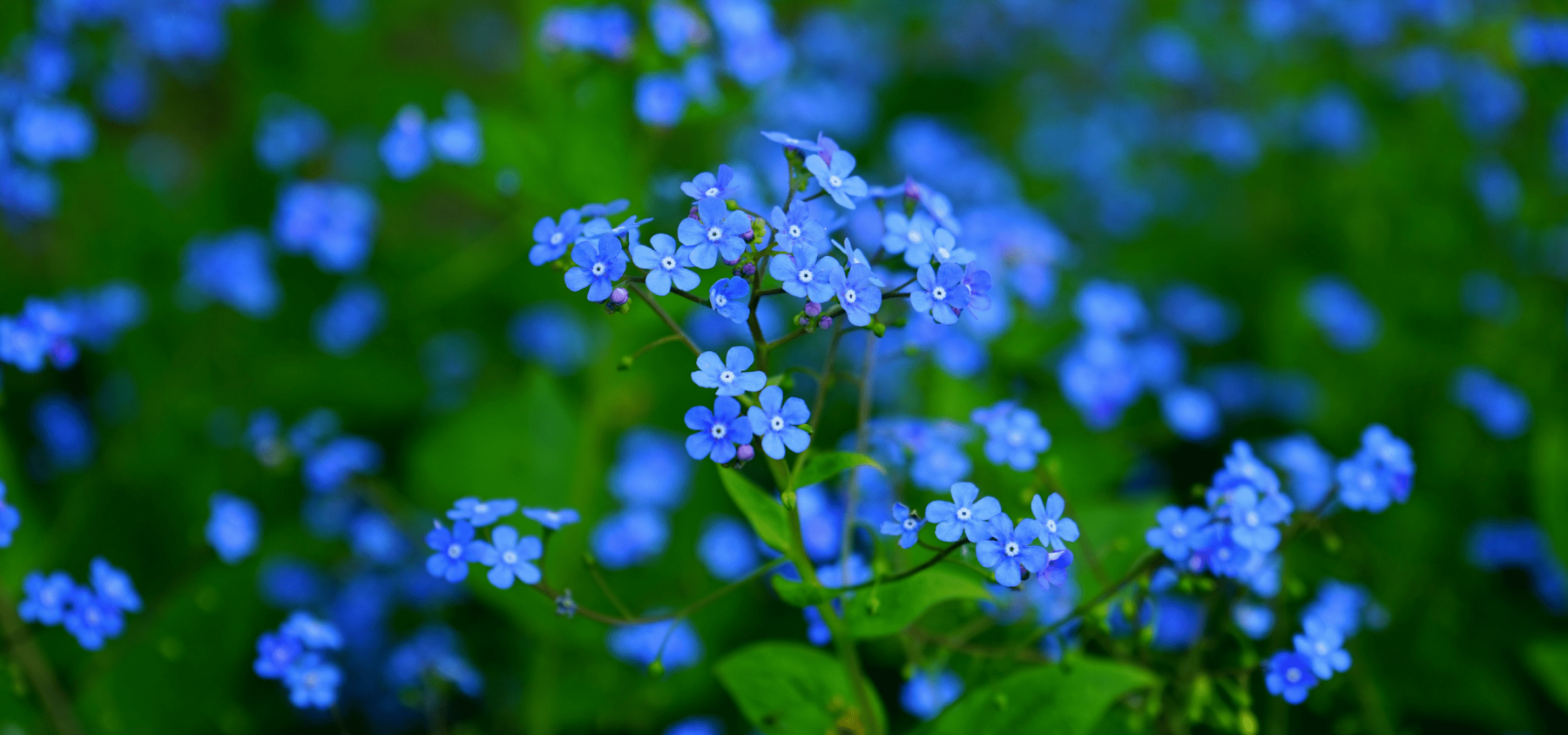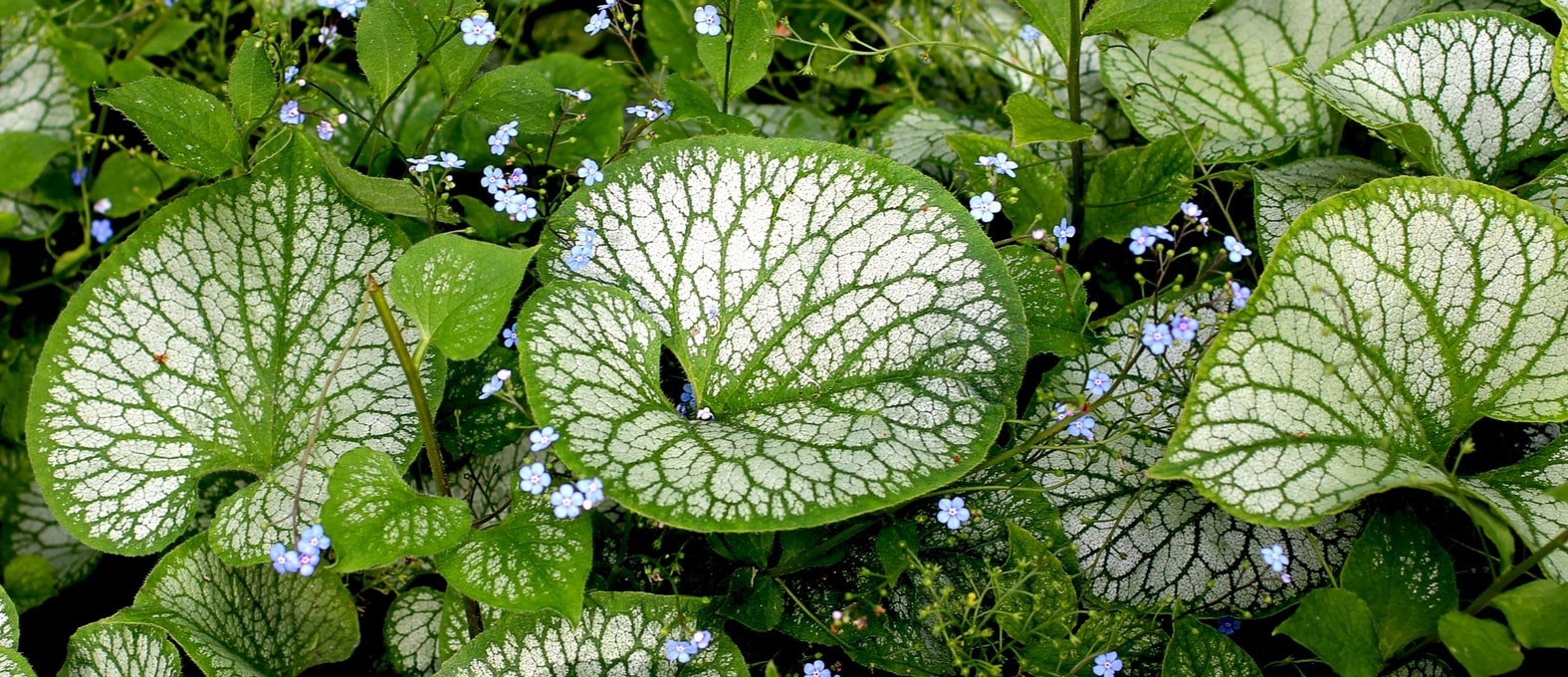
Successfully establishing the Caucasian forget-me-not
Brunnera macrophylla
Contents
The Siberian Bugloss, or Brunnera macrophylla, is a perennial plant native to Eastern Europe that bears delicate little blue flowers, very much resembling those of traditional Forget-me-nots. The flowers appear in early spring, sometimes as early as March, and last until May or June.
This plant offers a light, airy bloom that brings a natural, wild charm to the garden. It grows up to 40-50 cm tall with a spread of around 60 cm. The brunnera boasts decorative foliage, sometimes variegated, often silvery, somewhat reminiscent of hostas. It forms dense clumps and makes excellent ground cover. Easy to grow, the brunnera requires little maintenance. It is fully hardy and thrives in shady spots with moist soil. It’s the perfect plant for a woodland garden! You can pair it with other shade-loving plants like ferns and hostas.
Discover all our tips for successfully planting and growing Brunnera in your garden!
Which variety to choose?
The species type, Brunnera macrophylla, charms with its bright blue blooms that beautifully contrast with its heart-shaped green foliage. From this species, numerous horticultural varieties have been developed, offering a diversity of foliage with more or less silvery hues, sometimes variegated with creamy white. As for flowering, most varieties display small sky-blue flowers reminiscent of forget-me-nots, though some stand out with white blooms.
Among the most popular varieties:
- ‘Jack Frost’ : Its silvery foliage, veined with green, creates a striking contrast and brightens shady woodland areas. It’s one of the most popular and robust varieties.
- ‘Looking Glass’ : Even more silvery than ‘Jack Frost’, its foliage reveals only a thin green margin and subtle veining. Its mirror-like effect is spectacular, though this variety is slightly less vigorous.
- ‘Dawson’s White’ : Easily recognisable by its broad green leaves edged with creamy white, it brings lovely brightness to the garden. However, it is more delicate to grow and requires well-drained soil to prevent root rot.
- ‘Betty Bowring’ : A rarity with white flowers that stand out magnificently against its plain green foliage. Ideal for a soft and elegant ambiance.
- ‘Langtrees’ : Its green foliage dotted with small silvery spots adds an original and subtle touch. A lovely alternative for those seeking decorative yet more understated foliage compared to fully silvery varieties.
Lastly, also consider Brunnera sibirica, a close relative of B. macrophylla, which stands out for its ability to spread quickly via rhizomes. It forms dense, broad clumps and makes excellent ground cover for shaded areas.

Brunneras offer a wonderful diversity of foliage! From left to right, the varieties ‘Jack Frost’, ‘Looking Glass’, and ‘Dawson’s White’.
When to plant the Caucasian forget-me-not?
Brunnera macrophylla is planted in spring, from March to May, or in autumn, during October-November. Spring planting encourages good root establishment before summer, while autumn planting allows roots to develop before winter for vigorous growth. In colder regions, light mulching can protect young plants.
Where to plant it?
The Brunnera macrophylla is a woodland plant native to the forests of Eastern Europe, where it grows naturally under the shelter of trees. It will thrive in a semi-shaded or even fully shaded spot, away from direct sunlight which could scorch its foliage, although it can tolerate sun if the soil remains moist. Ideal as ground cover, it forms beautiful dense clumps and helps suppress weed growth.
It prefers a humus-rich, cool and slightly moist soil, with a rather heavy, clay-like texture. It tolerates rich and compact soils well, but dislikes excessive winter moisture which can lead to root rot. Conversely, soil that’s too dry, poor or stony would hinder its growth and development.

How to plant it?
- Soak the root ball in a basin filled with water
- Dig a planting hole, twice the size of the root ball
- We recommend adding organic matter (compost or well-rotted manure), especially if your soil lacks humus. Brunnera thrives in rich soils!
- Place the root ball in the planting hole.
- Fill in by replacing the soil all around, and firm down.
- Water thoroughly afterwards.
- You can apply mulch around the clump to keep the soil cool.
Continue watering in the weeks following planting.
How to propagate Caucasian forget-me-not?
Two techniques work well for propagating brunnera: division in late winter and root cuttings in autumn. This will allow you to easily obtain a large number of plants and create extensive ground cover. Sowing in spring is also possible.
You can divide clumps every three years, around March or in autumn (November). Dig them up, gently remove soil from around the roots if needed, then separate them into two or three sections. Keep only a few leaves to balance the root and foliage volume. Replant immediately and water well.
For root cuttings, proceed in autumn or winter. Dig up the clumps and take root sections of 4 to 5 centimetres. Plant them in a container filled with a mix of sand and compost, placed under shelter. Water thoroughly.
- Subscribe!
- Contents


































Comments